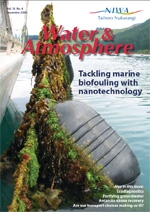Graham Fenwick and Mike Scarsbrook explain an ecological service going on beneath our feet.
PDF of this article (258 KB)





“Christchurch has one of the highest quality natural water supplies of any city in the world. Our water is purified naturally in underground aquifers. It is not treated chemically.”
This quotation from a brochure produced by Christchurch City Council’s Water Services Unit prompts a couple of key questions:
What is the nature of these natural purification processes within the aquifers of Canterbury (and other regions)? and Are they sustainable?
Research at NIWA has begun to shed light on this process of purification, demonstrating that groundwaters are living ecosystems that provide a fundamental ecological service for New Zealanders.
Life underground
Invertebrate animals – notably crustaceans commonly called well shrimps – have long been known from groundwaters, but their existence has generally been regarded as something of a curiosity. Over the past few years, we’ve found not only that these animals are widespread in groundwaters throughout New Zealand, but also that they are extremely diverse. Many of the species are unknown to science, lack scientific names, and are endemic to specific areas in New Zealand. They tend to be colourless and blind. Some have lost the ability to swim, and others are good swimmers. Most are small, so that they can occupy more of the tiny crevices and interstices within aquifers, but some well shrimps are up to 15–25 mm long.
A subterranean carbon cycle
Most ecosystems depend upon organic carbon fixed by plant photosynthesis to provide the basis for all food chains. So too do groundwater ecosystems, but rather than using plant material (which doesn’t grow underground), groundwater ecosystems rely on organic carbon carried in when surface waters recharge the aquifers. This organic carbon is either dissolved or in very fine particles that can percolate into the aquifer through minute pore spaces.
Once in the aquifer, this dissolved and fine-particle organic carbon gets bound into thin layers known as biofilms (slime layers that often contain bacteria) that form on all surfaces. Size doesn’t matter: biofilms adhere to all sizes of particles from clay grains to larger boulders and rock surfaces. In natural, uncontaminated aquifers, the groundwater animals feed on these layers. This grazing apparently keeps the biofilms in check, preventing them from clogging fine pore spaces, so that the aquifer continues to flow and water quality is maintained or improved.
Although the animals spend their entire lives within the aquifer, there are net losses of organic carbon from the system. As these animals feed, grow, and reproduce, their respiration releases organic carbon from the system as carbon dioxide. More carbon dioxide is lost by any microbial breakdown of their faeces and bodies when they die. Yes, the animals are small, but what they lack in body size, they make up in huge numbers and high turnover rates. Collectively, the groundwater animals can be a potent force in the groundwater ecosystem.
Pollution and sustainability
How sustainable are these processes in the face of increased groundwater pollution from human activities? At NIWA we’re examining the groundwater ecosystem response to land irrigation with treated wastewater. One of our study sites is at Leeston in Canterbury, where we’ve found the groundwater fauna changes in composition and abundance with increasing distance downstream from the oxidation ponds compared with upstream of the oxidation ponds and infiltration basins. At our other site in Whakarewarewa Forest, Rotorua, faunal response to spray irrigation of treated wastewater was similar: numbers of animals were highest close to the disposal area and decreased with increasing distance away from the irrigated area.
These results indicate that increased organic carbon entering the groundwater from contamination sources stimulates biofilm formation; that, in turn, increases densities of groundwater invertebrates. Grazing by these increased numbers of invertebrates keeps the biofilms in check, thereby maintaining water flow through fine pore spaces and the quality of water within the aquifer. In some highly contaminated wells, we find black, stinking sediment and organic matter; these conditions result from excessive organic carbon either clogging pores to slow water flows or else stimulating high bacterial populations that use up most of the available oxygen. Once dissolved oxygen becomes so scarce, anaerobic bacteria predominate, tainting the water with a characteristic rotten egg smell, and killing the invertebrates.
Thus, the research shows that the groundwater fauna performs an essential ecological service in maintaining the quality of the water, even under moderate contamination. But the animals cannot cope with excessive contamination: this results in reduced aquifer porosity and very low water quality, at least at local scales in the situations investigated so far.
Breaking it down
As this programme continues, we’re investigating links on the ecosystem’s carbon pathways and we’re working to understand seasonal changes in biofilms and associated animals. We also are attempting to quantify the various steps in the organic carbon pathways under differing organic carbon enrichment regimes as first steps towards predictive modelling of ecosystem responses to specified contamination levels. If this can be achieved, it should be possible to manage effluent disposal to maximise the groundwater ecosystem’s natural purification potential so that chemical or other human treatment of these immensely valuable resources is not required.
Pure from the ground up?
- A subterranean ecosystem helps keep groundwater pure by grazing on naturally accumulating carbon.
- Excessive carbon – for example from irrigation with effluent – can upset the ecosystem balance.
- Further research into the links within the purification system will help establish sustainable limits for contamination from various human activities.
Dr Graham Fenwick studies biodiversity and biosecurity; he’s based at NIWA in Christchurch. Dr Mike Scarsbrook, formerly a freshwater ecologist at NIWA, now works for DairyNZ Ltd.
This research is funded by the Foundation for Research, Science and Technology in the ‘Waste to Resource’ programme lead by Scion.
Teachers’ resource for NCEA Achievement Standards or Unit Standards: Biology Level 2 US6309, US6310, AS90714, Level 3 AS90713 Environmental Sustainability Level 2 AS90814 Science Level 3 AS90728
